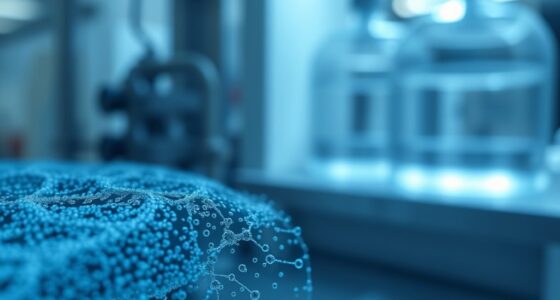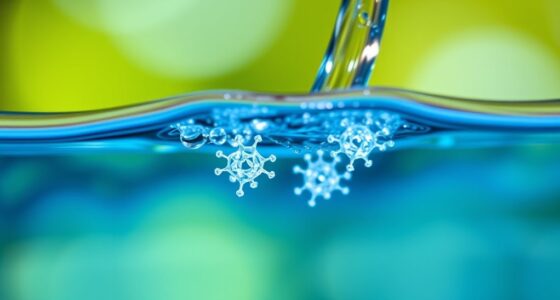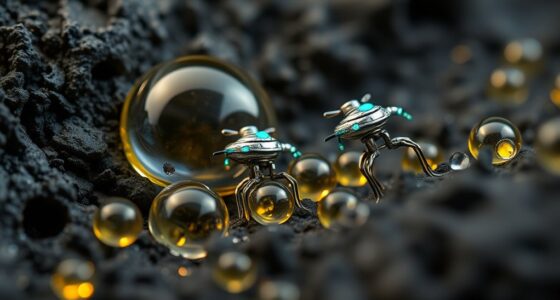Nanomachines for air purification and pollution control use advanced sensors to detect harmful pollutants like VOCs, nitrogen oxides, and fine particles. They can target and neutralize these toxins directly, working efficiently at a large scale. Designed with cutting-edge nanomaterials, these tiny devices can trap, decompose, or capture pollutants with high precision. If you want to learn how their safety, deployment, and environmental impacts are managed, keep exploring these innovative solutions.
Key Takeaways
- Nanomachines can detect and target specific airborne pollutants in real-time, enabling precise and efficient air purification.
- Engineered nanodevices function as microscopic factories to capture, neutralize, or remove pollutants from the environment.
- Advanced nanomaterials with high surface area and functionalization enhance pollutant adsorption and catalytic degradation.
- Safety and environmental regulations are essential to prevent risks related to nanomachine release and ecological impact.
- Long-term deployment of nanomachines promotes cleaner air, reduces secondary pollution, and supports sustainable environmental health.
How Nanomachines Detect and Target Pollutants

Nanomachines detect and target pollutants by leveraging highly sensitive sensors that can identify specific chemical signatures in the air. When pollutants enter their detection range, these sensors analyze the molecular structure, recognizing unique patterns associated with harmful substances like nitrogen oxides or volatile organic compounds. Once identified, the nanomachines activate their targeting mechanisms, which may involve releasing neutralizing agents or capturing the pollutants directly. This process is rapid, allowing for real-time response to changing air quality conditions. Thanks to their precision, nanomachines can distinguish between different pollutants, ensuring they act only on harmful substances. This targeted approach enhances efficiency, minimizes unnecessary reactions, and lays the foundation for sophisticated air purification systems that adapt dynamically to environmental needs. Additionally, integrating wickless candle making techniques can provide eco-friendly alternatives for localized air cleaning solutions, further improving air quality management.
Engineering Tiny Devices for Large-Scale Air Purification

To effectively purify large volumes of air, engineers design tiny devices that can be deployed at scale, overcoming the limitations of traditional filtration methods. These devices leverage nanotechnology to target pollutants directly and efficiently. You can think of them as microscopic factories working together, each with specific roles. To optimize their deployment, engineers consider factors like size, energy use, and durability. They develop scalable manufacturing processes, ensuring cost-effectiveness and rapid production. The table below highlights key parameters for engineering these devices:
| Parameter | Consideration |
|---|---|
| Size | Minimize to enhance mobility |
| Power Consumption | Optimize for energy efficiency |
| Material Durability | Ensure longevity in harsh environments |
Nanomachines can also incorporate advanced sensor technology to monitor air quality in real time and adjust their operations accordingly.
Breakthroughs in Nanomaterial Design for Pollution Control

Recent advances in nanomaterial design are transforming pollution control strategies. You’ll see how advanced nano-adsorbents can capture contaminants more effectively, while catalyst efficiency improvements speed up chemical reactions to neutralize pollutants. These breakthroughs are making air purification more powerful and scalable than ever before. Additionally, innovations in high-precision fabrication are enabling the production of more consistent and effective nanomaterials, further enhancing their performance in pollution mitigation.
Advanced Nano-Adsorbents
Advancements in nanomaterial design have revolutionized the development of nano-adsorbents, making them highly effective for air purification and pollution control. You now have access to materials with precisely engineered surface properties that enhance adsorption capacity and selectivity. These nano-adsorbents often feature porous structures, increasing surface area and enabling efficient capture of pollutants like volatile organic compounds (VOCs), heavy metals, and particulate matter. Innovations include functionalization techniques that add specific chemical groups, improving pollutant affinity. You can also utilize hybrid nanomaterials that combine different properties, boosting stability and regeneration. This progress allows you to design targeted, high-performance adsorbents capable of operating efficiently in diverse environments, markedly advancing air purification technologies and helping to reduce harmful emissions more effectively than ever before. Additionally, understanding the effectiveness and safety of these materials is crucial for real-world applications, ensuring they provide maximum benefit without unintended environmental impacts.
Catalyst Efficiency Improvements
Building on the progress in nano-adsorbents, researchers have made significant breakthroughs in nanomaterial design to enhance catalyst efficiency for pollution control. You’ll find that new nanostructures, like mesoporous nanoparticles and atomically precise catalysts, dramatically increase reaction surface areas and active sites. These innovations enable faster, more effective breakdown of pollutants such as NOx, SOx, and volatile organic compounds. By tailoring nanomaterials at the atomic level, you can improve catalyst stability and selectivity, reducing the energy needed for reactions. Advances in doping and surface modifications allow your catalysts to operate efficiently under a wider range of environmental conditions. Additionally, optimizing vetted – Mad Tasting nanomaterials ensures long-term performance and resistance to deactivation. Ultimately, these breakthroughs help you develop cleaner, more sustainable air purification systems that respond better to real-world pollution challenges.
The Role of Nanotechnology in Removing Particulate Matter

Nanotechnology plays a crucial role in removing particulate matter from the air by creating highly efficient filtration systems. These nanostructured filters are designed with materials that have incredibly small pore sizes, capable of trapping even the tiniest particles like PM2.5 and ultrafine dust. The nanomaterials increase surface area, enhancing the capture efficiency while maintaining low airflow resistance. You can benefit from these advanced filters in air purifiers, industrial stacks, and HVAC systems, reducing airborne pollutants effectively. Nanotech filters are also more durable and less prone to clogging compared to traditional options. By integrating nanomaterials, you guarantee cleaner indoor and outdoor air, helping protect respiratory health and improving overall air quality in polluted environments. Additionally, research supports that 16PF personality traits can influence individuals’ responses to air quality interventions, ensuring better public health strategies.
Decomposing Toxic Substances With Molecular Precision

Nanomaterials not only improve filtration but also enable precise chemical reactions that break down toxic substances at the molecular level. These nanomachines can target specific pollutants, transforming harmful chemicals into harmless compounds efficiently. This process relies on engineered catalytic sites that recognize and decompose pollutants like volatile organic compounds (VOCs), sulfur dioxide, and nitrogen oxides. By doing so, you reduce secondary pollution and improve air quality markedly. Understanding these reactions is key to optimizing nanomachine design. Engineered catalytic sites play a crucial role in ensuring the selectivity and efficiency of these nanomachines.
Challenges and Safety Considerations in Nanomachine Deployment

While nanomachines hold great promise for air purification, deploying them safely presents significant challenges. You must verify they don’t cause unintended environmental harm or human health risks. Controlling their behavior at the nanoscale is complex, and accidental release could lead to unforeseen consequences, such as toxicity or ecological disruption. Developing reliable delivery and containment methods is critical to prevent uncontrolled spread. Additionally, ethical concerns arise around transparency, regulation, and potential misuse. You also need to contemplate long-term effects, as nanomachines might accumulate in ecosystems or bodies, causing unknown health issues. Addressing these safety considerations requires rigorous testing, strict standards, and responsible innovation to balance benefits with potential risks effectively. Moreover, understanding the divorce statistics and legal frameworks related to environmental regulations can inform safer deployment strategies.
Future Perspectives and Potential Impact on Environmental Health

Looking ahead, nanomachines could markedly improve air filtration efficiency, making pollution control more effective. They also promise to reduce environmental toxicity by targeting pollutants more precisely, minimizing unintended harm. Over time, these advancements could lead to sustainable solutions that benefit both public health and the planet. Additionally, integrating nanomachines with hydrogen fuel cell technologies could further enhance pollution mitigation strategies, leveraging the renewable aspects of hydrogen to create cleaner energy systems.
Enhanced Air Filtration Efficiency
Advancements in nanomachine technology promise to substantially boost air filtration efficiency, leading to cleaner air and healthier environments. These tiny machines can be engineered to target and capture specific pollutants more effectively than traditional filters. Their high surface area and reactive capabilities enable them to trap and neutralize harmful particles, including viruses, bacteria, and chemical toxins, with greater precision. You’ll benefit from filters that require less maintenance and offer longer-lasting performance. Nanomachines can also adapt dynamically to changing air quality, optimizing filtration in real time. This innovation promises not only to enhance indoor and outdoor air quality but also to reduce energy consumption in filtration systems. As a result, you’ll experience healthier spaces while contributing to environmentally sustainable solutions. Incorporating adaptive technology into filtration systems can further improve responsiveness and overall efficiency.
Reduced Environmental Toxicity
The development of nanomachines for air purification is poised to substantially reduce the environmental toxicity associated with pollutants. These advanced devices target harmful airborne substances directly, minimizing their release into ecosystems. By effectively degrading toxic compounds, nanomachines lessen soil and water contamination, decreasing risks to wildlife and human health. They also reduce the need for chemical pollutants used in traditional cleaning methods, further lowering environmental burden. This technology’s precision helps prevent secondary pollution, promoting a cleaner environment overall. The table below highlights key benefits of reduced toxicity:
| Benefit | Impact | Example |
|---|---|---|
| Minimized chemical runoff | Less water and soil pollution | Lower pesticide residues |
| Decreased airborne toxins | Better air quality | Reduced respiratory issues |
| Eco-friendly degradation | Less persistent environmental residues | Faster pollutant breakdown |
| Reduced bioaccumulation | Safer food chains | Less toxin buildup in wildlife |
| Lower health risks | Improved public health | Fewer pollution-related diseases |
Long-Term Sustainability Benefits
As nanomachines for air purification become more integrated into environmental management strategies, their potential to guarantee long-term sustainability grows considerably. These tiny devices can continuously monitor and remove pollutants with minimal energy use, reducing reliance on traditional, resource-intensive methods. Their precision allows for targeted action, preventing excess waste and secondary pollution. Over time, nanomachines can adapt to changing air quality conditions, maintaining cleaner environments more efficiently. This responsiveness helps build resilient ecosystems and promotes healthier communities. Additionally, their durability ensures ongoing performance, lowering costs and reducing replacement needs. By enabling sustainable pollution control, nanomachines can notably decrease environmental degradation, supporting a cleaner planet for future generations. Their adoption promises a more sustainable, effective approach to air quality management worldwide.
Frequently Asked Questions
How Do Nanomachines Differentiate Between Harmful and Harmless Particles?
You see, nanomachines differentiate harmful from harmless particles by using specialized sensors and recognition mechanisms. These tiny devices detect specific chemical signatures, sizes, or shapes of pollutants. When they identify harmful particles, they activate targeted removal processes, like capturing or neutralizing them. Harmless particles are ignored or permitted to pass. This precise detection guarantees efficient air purification without removing beneficial particles, keeping your air safe and clean.
What Are the Energy Requirements for Nanomachines in Air Purification?
Think of nanomachines as tiny powerhouses, constantly needing energy to keep working. They use minimal energy—like a flickering candle—to remove pollutants efficiently. You’ll find they often draw power from ambient sources like air currents or light, making them energy-smart and sustainable. This means they operate with low energy demands, ensuring continuous purification without draining resources, much like a gentle breeze keeps a lantern glowing steadily.
Can Nanomachines Malfunction or Cause Unintended Environmental Effects?
Yes, nanomachines can malfunction or cause unintended environmental effects. If they lose control or degrade, they might release harmful substances or disrupt ecosystems. To prevent this, rigorous testing, fail-safe mechanisms, and strict regulation are essential. You should also monitor their operation continuously, ensuring they work as intended. Proper safeguards help minimize risks and protect the environment from potential adverse impacts caused by malfunctioning nanomachines.
How Scalable Are Nanomachine-Based Air Purification Systems?
You can scale nanomachine-based air purification systems quite effectively, as they can be designed for large-scale deployment across cities or industrial zones. These systems are adaptable and can be mass-produced relatively quickly, allowing for widespread use. However, scaling also involves ensuring safety, managing costs, and integrating with existing infrastructure. With careful planning and regulation, you can expand these systems to markedly improve air quality on a broad level.
What Regulations Govern the Deployment of Nanomachines in the Environment?
You should remember, “Better safe than sorry.” Regulations on deploying nanomachines in the environment vary by country, often involving agencies like the EPA or EPA equivalents. These rules cover safety testing, environmental impact assessments, and ongoing monitoring. You must comply with international treaties and local laws, ensuring transparency and risk management. Staying informed and working with regulatory bodies helps you navigate approval processes and deploy nanomachines responsibly.
Conclusion
As you explore nanomachines for air purification, consider that they could reduce airborne pollutants by up to 90%, drastically improving air quality. With their ability to target and decompose toxic substances precisely, you have the power to combat pollution more effectively than ever before. While challenges remain, embracing this technology could notably protect your health and the environment. Imagine a world where cleaner air is achievable—nanomachines are bringing that future closer to reality.









